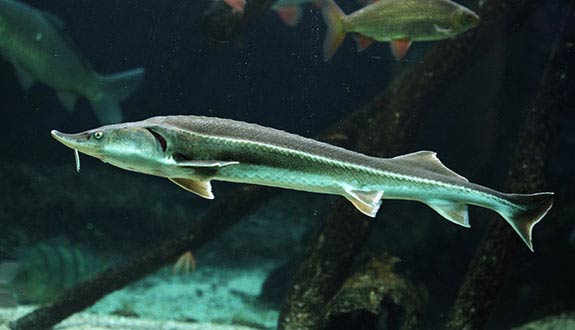

Alternative species (click on the thumbnail to see the card)
Names
Scientific name
Acipenser ruthenus
Acipenser gmelini
Acipenser kamensis
Acipenser kankreni
Acipenser kostera
Acipenser lovetzkyi
Acipenser marsiglii
Acipenser pygmaeus
Sterledus ruthenus sibiricus
Common name
Sterlet
Origin

Origin: Europe, Siberia
Biotope: not specific
Dimorphism
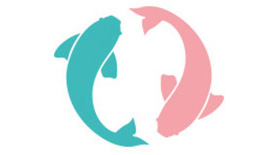
None
Group
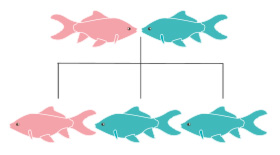
Acipenseridae
Volume

10000 L / 2200 Imp Gal / 2650 US Gal
then for 1: 3000 L / 660 Imp Gal / 793 US Gal
Parameters

T°: 4 to 24°C or 40 to 75°F
pH: 7 to 8
Hardness: 8 to 12°dGH
Difficulty
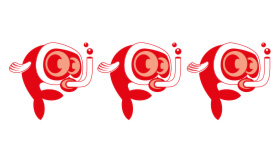
Hard
Size

40 to 125cm (16 to 50")
Longevity
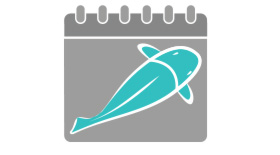
20 to 25 years
Living zone

Depth
Individuals
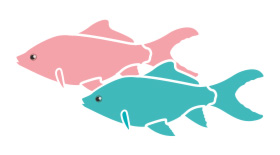
2
Food
How to feed the Sterlet?
Food
How to feed the Sterlet?
The Sterlet feeds mainly on benthic organisms such as mayflies, mud worms, small crustaceans or small molluscs.
To feed it with pellets, choose specialized food (special sturgeon or sterlets) and good quality. They must fall immediately to the bottom of the pond as sturgeon feed exclusively in this area.
In winter, unlike many fish, the Sterlet continues to feed. Feed your fish all year round!
Behavior
What kind of behavior does the Sterlet have?
Behavior
What kind of behavior does the Sterlet have?
It is a calm and slow fish, but it swims constantly. It cannot swim backwards, and will not be able to get itself out of a dead end, a dangerous situation for it: beware of the shape of your pool!
Not very fearful and without territorial spirit, he easily lets himself be approached. However, don't touch him because it risks damaging his skin (removing its protective film) and making him fall ill.
Cohabitation
Who can live with the Sterlet?
Cohabitation
Who can live with the Sterlet?
He likes the presence of his fellow creatures, and the maintenance of 2 individuals will be the bare minimum to observe.
Even if they are calm and peaceful fish, the difficulty of associating it with other fishes residing in the food competition. Indeed, in front of goldfish or carp, there will not be much food left for this placid giant. To be avoided.
Beware of maintenance with other sturgeon species because of the risk of hybridization.
Breeding
How to breed the Sterlet?
Breeding
How to breed the Sterlet?
Sturgeons do not breeding in a pond, since spawning is the result of migration into the natural environment.
This fish takes quite a long time to reach sexual maturity since reproduction is only possible with males aged at least 3/4 years and females aged 7 to 9 years. This sturgeon reproduces exclusively in fresh water. After a spring migration during which the fish swim upstream (males are first, then females follow), the spawning eggs are deposited directly on the substrate. The eggs are small (1.5 mm) and viscous. A single female can lay between 11,000 and 140,000 eggs in one season. Incubation lasts between 4 and 9 days. At birth, the small fry are self-sufficient.
Its pond
Which pond for the Sterlet?
Its pond
Which pond for the Sterlet?
The basin must be at least 10 m3 or 10000 L / 2200 Imp Gal / 2650 US Gal. Add 3 m3 or 3000 L / 660 Imp Gal / 793 US Gal for each additional fish. The surface area and shape of the pond will be the most important factor. The height of the water is not important, as sturgeons live naturally in shallow water (count at least 1 metre anyway). These measurements make it easier to speak of ponds or small lakes.
The pond should be sufficiently large, oval and free of obstacles. This is because the sterlet cannot turn back and can get stuck in too narrow a spot in the pond, putting its life at risk. It must also be able to turn around without hindrance: this will require a good width, as it can be more than a metre wide!
The terlet likes rather cold water: shade your pond as much as possible. It also requires very oxygenated water. A large waterfall or a waterfall is therefore imperative to provide for its oxygen needs. From 21°C, complete your installation with an air diffuser (bubbler) adapted to the volume of your pond to increase the oxygen level. The water must also be clean and well filtered.
Avoid the presence of filamentous algae because the Sterlet can get stuck in it (or even die asphyxiated in this way, since it no longer moves). This applies to all plants.
The ground can be covered with mud, but this is not obligatory: a bare bottom is also suitable.
In winter, do not heat the pond water, as sturgeon appreciate cold water. Beware, it must not freeze (you will not be able to feed the sturgeon)!
Good To know
Find all additional information!
Good To know
Find all additional information!
His detention is subject to a certificate of competency.
It is one of the smallest species of sturgeon with an average size of between 1 and 15 metres (3 and 49 feet).
There is an albino variety of this species.
It must consent to swim in order to be able to breathe properly, like sharks! Besides, it cannot swim backwards but always forwards.
Unfortunately, this species is endangered in its natural environment. This situation is mainly due to its exploitation in the production of caviar. It is classified as "vulnerable" in the red list of the IUCN (International Union for Conservation of Nature and Natural Resources). It is also protected by other bodies and its trade is regulated:
- Habitat-Fauna-Flora Directive: Annex V
- ommunity CITES Regulation: Appendix B
- Bonn Convention: Annex II
- CITES (Washington Convention): Appendix II
- Bern Convention: Appendix III
In the wild, its size can sometimes reach 1.5 metres (3.3 feet). In captivity, it rarely exceeds 90 cm (36").
Its 4 barbels are sensory organs that enable it to search for food by digging in the ground.
There are 26 species of sturgeon, some of which can hybridize with each other (sterile offspring).
Yours photos!
Comments
Sort by:
Please login to post comments
